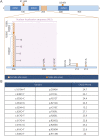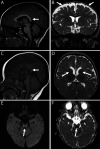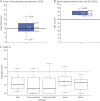Detailed Clinical and Psychological Phenotype of the X-linked HNRNPH2-Related Neurodevelopmental Disorder
- PMID: 33728377
- PMCID: PMC7954461
- DOI: 10.1212/NXG.0000000000000551
Detailed Clinical and Psychological Phenotype of the X-linked HNRNPH2-Related Neurodevelopmental Disorder
Abstract
Objective: To expand the clinical phenotype of the X-linked HNRNPH2-related neurodevelopmental disorder in 33 individuals.
Methods: Participants were diagnosed with pathogenic or likely pathogenic variants in HNRNPH2 using American College of Medical Genetics and Genomics/Association of Molecular Pathology criteria, largely identified via clinical exome sequencing. Genetic reports were reviewed. Clinical data were collected by retrospective chart review and caregiver report including standardized parent report measures.
Results: We expand our clinical characterization of HNRNPH2-related disorders to include 33 individuals, aged 2-38 years, both females and males, with 11 different de novo missense variants, most within the nuclear localization signal. The major features of the phenotype include developmental delay/intellectual disability, severe language impairment, motor problems, growth, and musculoskeletal disturbances. Minor features include dysmorphic features, epilepsy, neuropsychiatric diagnoses such as autism spectrum disorder, and cortical visual impairment. Although rare, we report early stroke and premature death with this condition.
Conclusions: The spectrum of X-linked HNRNPH2-related disorders continues to expand as the allelic spectrum and identification of affected males increases.
Copyright © 2021 The Author(s). Published by Wolters Kluwer Health, Inc. on behalf of the American Academy of Neurology.
Figures





Similar articles
-
Variant-specific effects define the phenotypic spectrum of HNRNPH2-associated neurodevelopmental disorders in males.Hum Genet. 2022 Feb;141(2):257-272. doi: 10.1007/s00439-021-02412-x. Epub 2021 Dec 14. Hum Genet. 2022. PMID: 34907471 Free PMC article.
-
Variants in HNRNPH2 on the X Chromosome Are Associated with a Neurodevelopmental Disorder in Females.Am J Hum Genet. 2016 Sep 1;99(3):728-734. doi: 10.1016/j.ajhg.2016.06.028. Epub 2016 Aug 18. Am J Hum Genet. 2016. PMID: 27545675 Free PMC article.
-
Missense variants in the Arg206 residue of HNRNPH2: Further evidence of causality and expansion of the phenotype.Am J Med Genet A. 2020 Apr;182(4):823-828. doi: 10.1002/ajmg.a.61486. Epub 2020 Jan 14. Am J Med Genet A. 2020. PMID: 31943778
-
Clinical spectrum of KIAA2022/NEXMIF pathogenic variants in males and females: Report of three patients from Indian kindred with a review of published patients.Brain Dev. 2020 Oct;42(9):646-654. doi: 10.1016/j.braindev.2020.06.005. Epub 2020 Jun 27. Brain Dev. 2020. PMID: 32600841 Review.
-
Trio exome sequencing identified a novel de novo WASF1 missense variant leading to recurrent site substitution in a Chinese patient with developmental delay, microcephaly, and early-onset seizures: A mutational hotspot p.Trp161 and literature review.Clin Chim Acta. 2021 Dec;523:10-18. doi: 10.1016/j.cca.2021.08.030. Epub 2021 Aug 31. Clin Chim Acta. 2021. PMID: 34478686 Review.
Cited by
-
Deliberate paradigm shift in research in rare neurodevelopmental disorders.Orphanet J Rare Dis. 2021 Jun 9;16(1):263. doi: 10.1186/s13023-021-01885-3. Orphanet J Rare Dis. 2021. PMID: 34107995 Free PMC article.
-
A Prospective, Longitudinal Study of Caregiver-Reported Adaptive Skills and Function of Individuals with HNRNPH2-related Neurodevelopmental Disorder.Adv Neurodev Disord. 2024;8(3):445-456. doi: 10.1007/s41252-023-00346-1. Epub 2023 Aug 7. Adv Neurodev Disord. 2024. PMID: 39220267 Free PMC article.
-
Rett-like Phenotypes in HNRNPH2-Related Neurodevelopmental Disorder.Genes (Basel). 2023 May 26;14(6):1154. doi: 10.3390/genes14061154. Genes (Basel). 2023. PMID: 37372334 Free PMC article.
-
Variant-specific effects define the phenotypic spectrum of HNRNPH2-associated neurodevelopmental disorders in males.Hum Genet. 2022 Feb;141(2):257-272. doi: 10.1007/s00439-021-02412-x. Epub 2021 Dec 14. Hum Genet. 2022. PMID: 34907471 Free PMC article.
-
A murine model of hnRNPH2-related neurodevelopmental disorder reveals a mechanism for genetic compensation by Hnrnph1.J Clin Invest. 2023 Jul 17;133(14):e160309. doi: 10.1172/JCI160309. J Clin Invest. 2023. PMID: 37463454 Free PMC article.
References
-
- Vorstman JAS, Parr JR, Moreno-De-Luca D, Anney RJL, Nurnberger JI Jr, Hallmayer JF. Autism genetics: opportunities and challenges for clinical translation. Nat Rev Genet 2017;18:362–376. - PubMed
-
- Bassani S, Zapata J, Gerosa L, Moretto E, Murru L, Passafaro M. The neurobiology of X-linked intellectual disability. Neuroscientist 2013;19:541–552. - PubMed
-
- des Portes V. X-linked mental deficiency. Handb Clin Neurol 2013;111:297–306. - PubMed
LinkOut - more resources
Full Text Sources
Other Literature Sources
